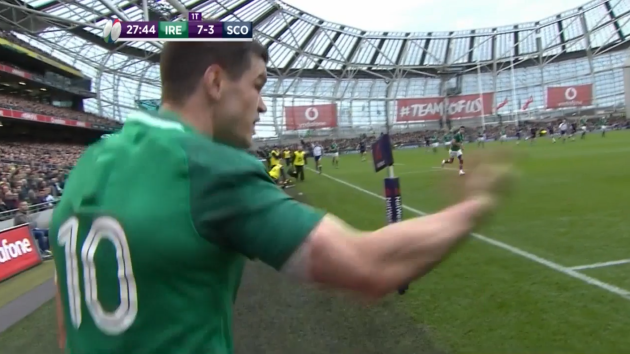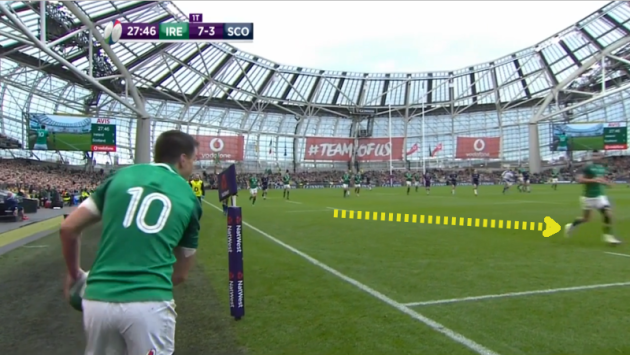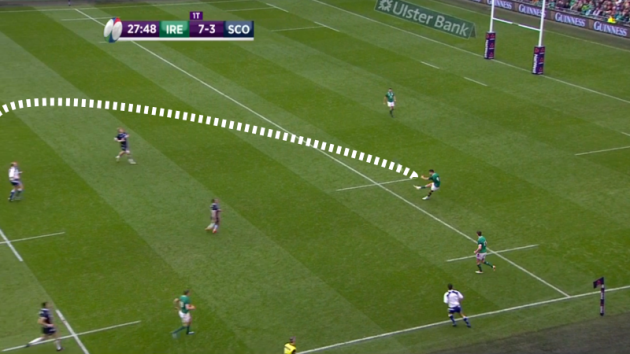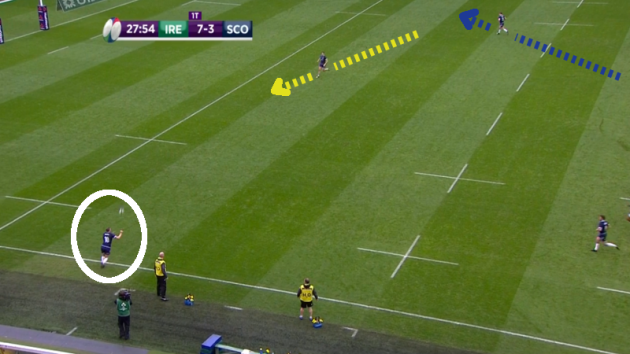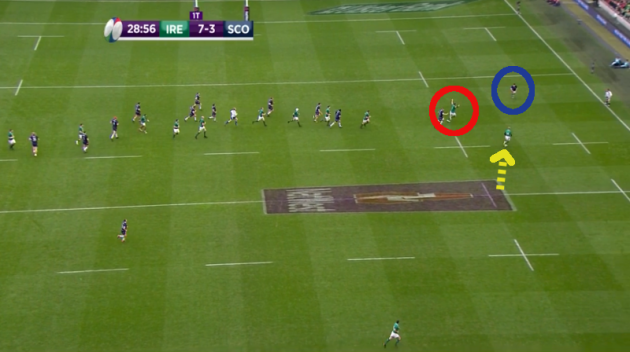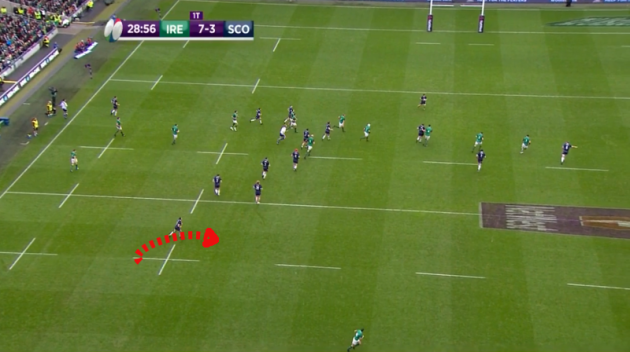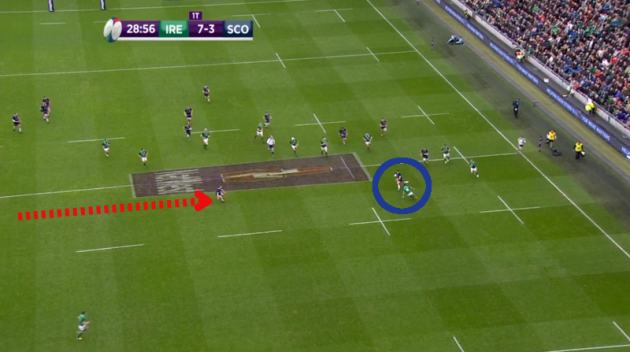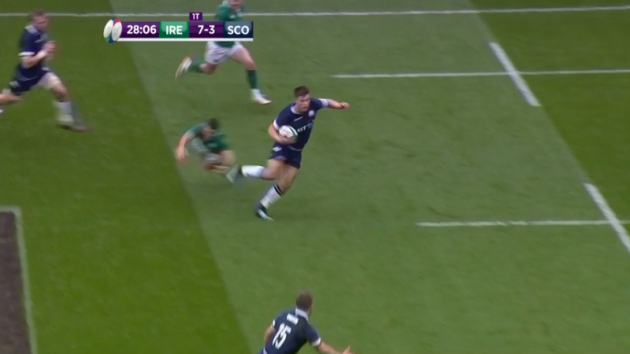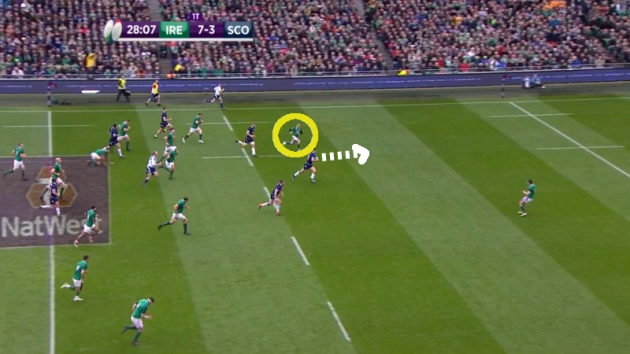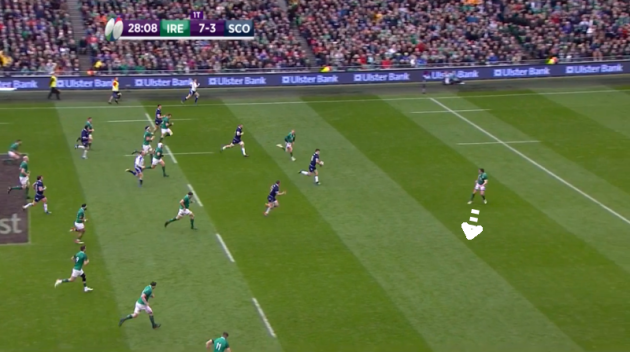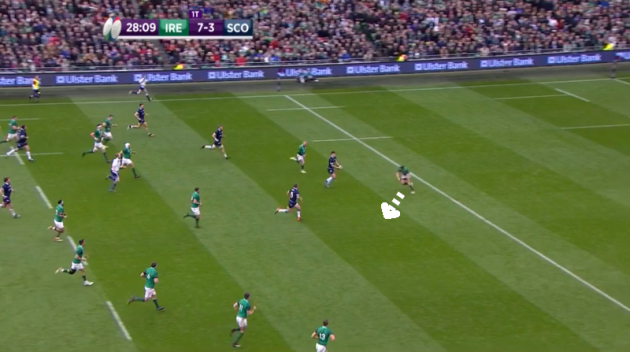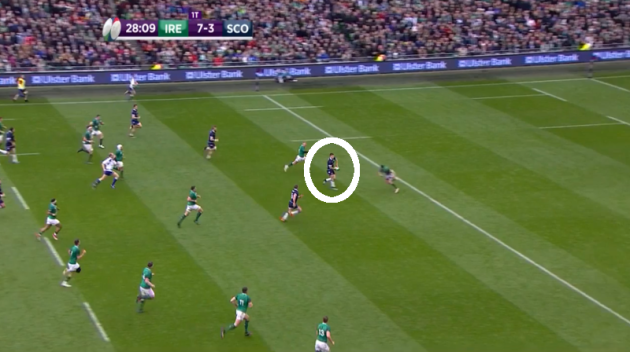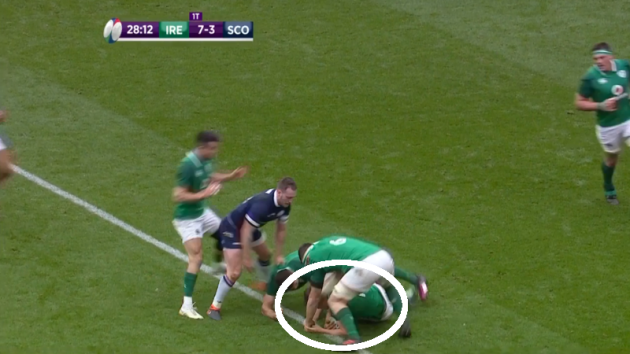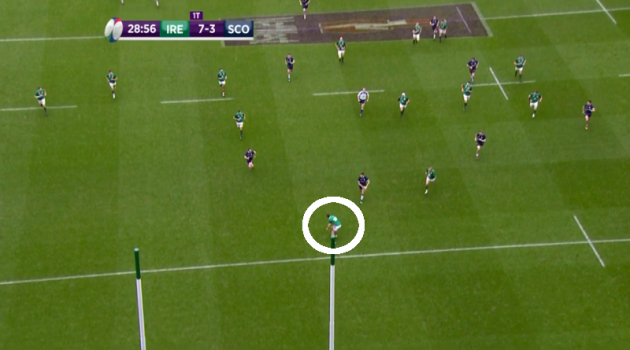JOHNNY SEXTON IS Ireland’s creator in chief and tactical leader but he is also one of their finest defenders.
We have seen big impacts from the Ireland out-half throughout Ireland’s championship success – moments like a hammering hit on Ross Moriarty to drive him over the Welsh tryline in round three stand out – and there was another on Saturday against Scotland.
Gregor Townsend’s side butchered three clear try-scoring opportunities in Dublin but the defence – even when scrambling – is always a factor in these kinds of chances going awry.
Sexton’s involvement in the first-half went a long way towards ensuring that Huw Jones didn’t convert perhaps the most gilt-edged possibility in the game – when a converted try would have sent the visitors into a 10-7 lead just before the half-hour mark and naturally changed the course of the game.
The passage begins in the 28th minute as Stuart Hogg smashes a long clearing kick into touch in Ireland’s 22.
Sexton is covering the backfield and catches the ball in touch, before showing his exasperation that Rob Kearney hasn’t come towards the left touchline to show for a quick lineout throw.
However, the retreating Conor Murray works hard to get back and offer an option for Sexton, as we see below.
Sexton passes infield to Murray, giving the scrum-half plenty of time to fire his own clearing kick downfield and into touch around 30 metres out from the Scottish tryline.
As Ireland would have highlighted before the game, Scotland love to get their lineouts into play as rapidly as possible.
Murray recognises that his kick isn’t going to go deep into touch and immediately begins to sprint upfield, seeing that Finn Russell is waiting just over the touchline to launch the Scottish attack.
This is where Scotland are so dangerous and as Russell takes the quick throw-in to himself [white below], we can see how Townsend’s side bring some basic structure to creating the chance.
Wing Sean Maitland shifts infield [yellow above] from his initial position out on the left, meaning he can offer Russell an option to pass infield.
Meanwhile, centre Jones tracks back [blue above] from the midfield into the space that Maitland has vacated, ensuring that Scotland will have the option to attack out on that side of the pitch if and when Russell shifts the ball on to Maitland.
Scotland do throw the two long passes from right to left, looking to get outside the advancing Irish defence.
Ireland will feel they could have worked harder across the pitch in midfield when it became clear that Russell was going to pass infield, therefore allowing them to pressure Jones [blue above] a little more, but the centre does superbly in space.
Cian Healy [red above] is on the edge of the Irish frontline and fairly exposed out there, meaning wing Keith Earls feels the need to advance up [indicated by yellow above] from an initial position where he has hung back to cover a possible Scotland kick.
Jones’ chip into that space – with no Irish player sweeping across – is excellent and he regathers after one bounce to suddenly open up the opportunity.
We must highlight Hogg’s intelligent work to give Jones the passing option here once he has regathered.
As Russell is getting set to pass to Maitland in the shot above, we can see that Hogg has retreated back down the pitch [red above] after chasing his original kick all the way up to just outside Ireland’s 22.
As Russell then finds Maitland, Hogg begins to appreciate the possibility of what is to come and he drastically changes his line, cutting infield [red below]
By the time Jones [blue below] has regathered his chip and is in the process of beating Kearney, we can see that Hogg has worked all the way across to be in an ideal supporting position.
Kearney’s life is very difficult in the instance we see unfolding above.
Having started deep in Ireland’s backfield to cover a possible long return kick from the Scots, he has to sprint forward once he recognises that Jones has dinked the chip over the top.
As the ball sits up perfectly for Jones, he has huge space on either side of the fast-advancing Kearney and it’s an extremely favourable position for the attacking player to be in.
Kearney will, of course, be frustrated that he could not get a better shot on Jones but it’s certainly a difficult tackle to make.
As Jones slips around Kearney, Ireland are into panic mode but one player has the crucial composure just to push that panic slightly back onto the Scots.
Upon rounding Kearney, Jones has a quick glance to his left, where the extremely hard-working Earls is getting up to peak speed in his attempt to cover back.
Jones is just briefly glancing to his left in the shot above and his peripheral vision picks up Earls [yellow] tracking back, dissuading the Scotland centre from viewing that left corner as a possibility for finishing himself.
Earls even gets a hand up to point infield – either indicating to Sexton that he can get to Jones or attempting to signal the presence of Hogg. Either way, Earls’ work rate suddenly narrows Jones’ options.
Still, the try-scoring opportunity is very, very clear.
The brilliance of Sexton’s contribution is in his body shape, which we can see below at an early stage.
Sexton has not commited to dealing with Jones here, instead backing off.
Most importantly, Sexton has kept his body open to his left, the intention being to signal to Jones that he can still cover across onto Hogg if Jones releases his pass at this stage.
A couple of steps from Jones later and Sexton still isn’t giving the Scotland centre the cue he wants – namely, Sexton turning his shoulders towards Jones and leaving Hogg completely free.
And even at the last split second, when Sexton actually plants his left leg to finally engage Jones, he still has his body open to Hogg, still putting that doubt in Jones’ mind.
Let’s stress again that this is try-butchery so criminal that someone should have immediately contacted the Gardaí, but it’s worth noting what Sexton’s brilliant defence does to Jones.
It turns an obvious pass into one that Jones ends up getting away on Sexton’s terms, rather than his own.
He’s been coached all of his rugby playing life to commit the defender before passing, but Sexton will not give him that cue by turning his shoulders towards Jones and signifying that he is going to tackle him.
Jones delays and delays and when Sexton does finally plant to tackle, Jones is left to pass from a weaker position that he would want to.
Jones is releasing his pass in the split second we have captured above and we can see that he is passing from the base of his inside foot.
Now, the best players in the world work hard to be able to fire accurate passes whether they’re planting on their inside or outside foot, but in this instance, Jones would likely have been more comfortable passing off his outside foot – most likely allowing him to get a firmer follow-through in directing the power towards Hogg.
But Sexton’s superb body shape sows the seed of indecision in Jones’ mind as he moves at great speed.
The out-half’s refusal to commit begins to flip the pressure back onto the Scotland centre.
Jones’ hesitance is incredibly costly as the pass is not released on his terms, and we see the result as the ball goes to ground in front of Hogg…
… allowing the retreating Garry Ringrose to gleefully fall onto it and reclaim possession for Ireland.
When we look at the opportunity from behind the goalposts, the sheer scale of the missed opportunity is underlined.
It’s obviously very easy to point all of this out with the benefit of multiple angles and replays, as well as without the pressure of being in a Test match, but Jones [blue] will feel he could have passed to Hogg as early as the moment below.
Hogg’s pace is exceptional and he is ready to shift up to top speed as soon as he gets the ball.
With no retreating defender out on the left of the shot above within touching distance, Hogg could take an angled run [red] to the tryline if required.
But Sexton is backing off [white] while keeping his body open towards Hogg, just putting that doubt in Jones’ mind - ‘Can Sexton catch Hogg if I pass now?’
A couple of steps later and Jones still has a chance to pass. He wants to pass more than anything, he knows he needs to pass.
But still Sexton is stubborn in his body shape, he still won’t give that permission to Jones to pass by turning in towards him.
And when Sexton finally does give Jones the nod, allowing him to pass, it’s too late.
The work-rate of Earls – look how close he has got after working back [yellow] – is vital and initially narrows Jones’ options.
Yet, it is the intelligence and decision-making from Sexton that stands out most of all, turning a certain try into a butchered try.
Jones could have and should have passed earlier but Sexton’s intervention made all of the difference.
- Originally published at 11.25

